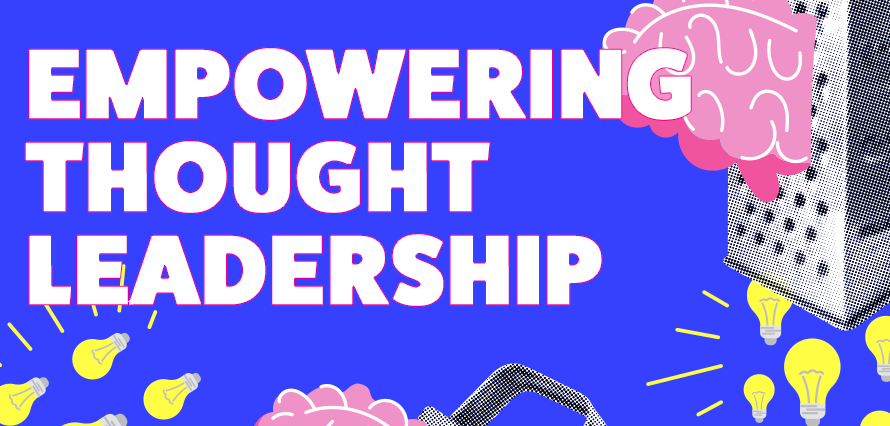June 27, 2024

In modern marketing, thought leadership has emerged as a powerful strategy for building trust, authority, and deeper customer connections. However, many marketers face significant challenges in motivating and equipping their leaders to excel in this area. Inspired by the podcast episode Leading from the Front, this blog explores common challenges and provides actionable solutions to help you foster effective thought leadership within your organisation.
🔍 Addressing Attention
Leaders rarely receive the undivided attention needed for deep self-reflection and growth. Start implementing regular, dedicated thought sessions for your leaders. These one-on-one interactions provide a focused space for them to explore their thinking, behaviours, and strategies, leading to greater self-awareness and more impactful content.
🧠 Cultivating Self-Reflection
Many leaders have not developed the habit of deep self-reflection, missing opportunities to refine their mindset and approach. Encourage leaders to engage with powerful, thought-provoking questions that prompt introspection about their mindset, feelings, and behaviours. This practice can uncover new insights and foster a growth-oriented mindset essential for thought leadership content to resonate with others.
💪 Boosting Confidence
Leaders often feel unequipped to realise their potential, leading to hesitation and underperformance. Share success stories and statistics that highlight the value of thought leadership. For instance, emphasising that decision-makers trust thought leadership more than traditional marketing can motivate leaders to embrace and commit to these efforts.
👀 Overcoming Scepticism
There is often scepticism or a lack of awareness regarding the benefits of thought leadership, which can hinder leaders from fully engaging in the process. Try offering testimonials and case studies showcasing the transformative power of thought leadership. Demonstrating real-world examples where thought sessions have significantly improved leadership effectiveness can help dispel doubts and encourage participation.
🧭 Navigating Discomfort
Many leaders feel uncomfortable with the concept of thought leadership in general, perceiving it as daunting or unnatural. Start normalising the discomfort by addressing it directly in thought sessions. Help leaders understand that their unique perspectives and experiences are valuable. Provide them with tools and frameworks to build confidence gradually.
📈 Enhancing Quality
Statistics indicate that only 15% of decision-makers rate most thought leadership as very good or excellent, reflecting an enormous quality gap. Continuous improvement through feedback and thought sessions will make a huge difference. Encourage leaders to seek feedback on their content and provide constructive insights to help them refine their approach and enhance quality.
⏰ Managing Time Constraints
Leaders often struggle to find time or feel capable of producing high-quality content. Implement a structured approach using the SMART goal-setting framework (Specific, Measurable, Achievable, Relevant, and Time-bound). Clear, well-defined goals make it easier for leaders to allocate time and resources effectively towards thought leadership activities.
🔄 Feedback Loop
A negative feedback loop can develop where a lack of confidence is present, which then only reinforces the lack of confidence. To break this cycle, celebrate small wins and progress. Recognise and reward leaders for their efforts and provide positive reinforcement to build confidence and encourage continuous improvement.
🎯 Setting Clear Goals
A lack of specificity in thought leadership goals can also make it challenging to motivate and guide leaders effectively. Utilise the GROW Model (Goal, Reality, Options, Way-forward) to structure goal-setting conversations. This model helps clarify objectives, assess current realities, explore options, and define actionable steps, ensuring leaders are aligned and motivated.
✨ Inspiring Motivation
Marketers often struggle to motivate business leaders to engage more actively in thought leadership, affecting the organisation’s ability to build closer customer relationships. Highlight the strategic importance of thought leadership in modern marketing. Share data such as the fact that 73% of buying decision-makers trust thought leadership more than traditional marketing. Emphasise the competitive advantage and customer trust that effective thought leadership can bring.
Thought leadership is more than a marketing tactic; it’s a pathway to establishing authority, building trust, and fostering deeper customer relationships. By addressing common pain points and implementing structured, supportive approaches, you can empower your leaders to excel. Embrace the power of thought sessions, set clear goals, and celebrate progress to unlock the full potential of your organisation.
Ready to transform your leaders into thought legends? Contact us today to learn how to drive your thought leadership social media content strategy forward.